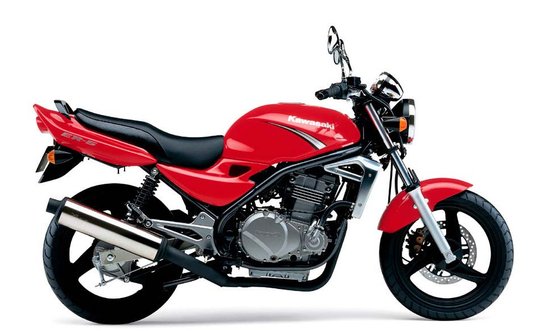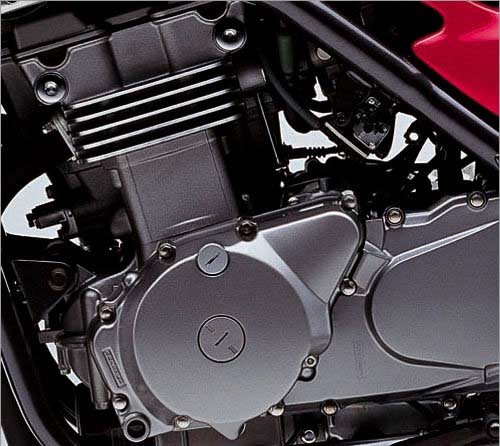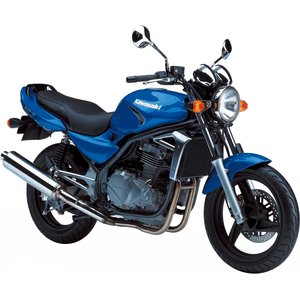Kawasaki ER-5 Twister [2001-2006]: The Approachable Parallel Twin That Won Over Commuters

Introduction
The Kawasaki ER-5 Twister represents an era when motorcycle manufacturers prioritized simplicity and accessibility over cutting-edge technology. Produced from 2001 to 2006, this naked bike carved its niche as a friendly companion for daily commutes and entry-level riders seeking reliability. Built around the proven engine architecture of the GPZ500S, the ER-5 wasn’t designed to set racetracks ablaze, but to deliver a balanced, no-nonsense riding experience. Let’s explore why this understated twin remains relevant in used markets and how it holds up against modern expectations.
Engine Performance: Smooth Operator With a Dual Personality
At the heart of the ER-5 lies a liquid-cooled 498cc parallel twin engine with DOHC and four valves per cylinder. Output figures hover around 50 HP (37 kW) at 8,500 RPM and 45.2 Nm (33.3 lb-ft) of torque at 7,000 RPM. These numbers might seem modest, but the engine’s character is its true strength.
The twin’s power delivery is linear and forgiving, with a broad torque curve that pulls cleanly from 4,000 RPM. Below that, vibrations start to creep in, especially around 3,500 RPM – a minor annoyance during highway cruising but easily mitigated by short-shifting. Keep the revs above 5,000 RPM, and the ER-5 transforms into a surprisingly peppy machine, with a throaty exhaust note that’s more assertive than its specs suggest.
Fueling comes via twin 34mm Keihin CVK carburetors (later models reportedly switched to injection, though this appears inconsistent in documentation). Cold starts require patience, with a 2-3 minute warm-up recommended before riding. Once up to temperature, throttle response is crisp, though abrupt wrist movements can cause slight hesitation – a trait common to CV carbs.
Key Strengths:
- Fuel efficiency: ~4.2 L/100 km (56 mpg) achievable with conservative riding
- Low maintenance: Hydraulic valve lifters eliminate manual adjustments (contrary to earlier specs showing valve clearance requirements – verify model year)
- Durability: Reports of engines surpassing 100,000 km (62,000 mi) with basic care
Chassis & Handling: Lightweight Agility Over Precision
Weighing 179-180 kg (394-397 lbs) dry, the ER-5 feels flickable in urban environments. The steel cradle frame and 37mm telescopic forks provide adequate stiffness for casual riding, though aggressive cornering exposes their limitations. Front suspension travel is 125 mm (4.9 in), while the rear shocks offer 114 mm (4.5 in) of travel with five-step preload adjustment.
At moderate speeds, the setup soaks up bumps competently, but sharper impacts transmit noticeable feedback through the bars. The 17-inch cast wheels (110/70 front, 130/70 rear) offer neutral turn-in, and the 1430 mm (56.3 in) wheelbase strikes a balance between stability and maneuverability.
Braking performance is the chassis’ weak link. The single 280mm front disc with a two-piston caliper lacks bite, requiring a firm squeeze for urgent stops. The 160mm rear drum feels wooden and is best reserved for speed modulation rather than hard braking. Modern sintered pads and steel-braided lines (available through MOTOPARTS.store) significantly improve feel and stopping power.
Ergonomics & Design: Function Over Flair

The ER-5’s upright riding position caters to riders of all experience levels. The 800-815 mm (31.5-32.1 in) seat height accommodates shorter inseams, and the narrow tank profile allows easy ground reach. Handlebar placement creates a slight forward lean – enough for control without straining wrists during hour-long commutes.
Pillion accommodation is basic but usable, with a slim rear seat and passenger pegs set low enough for adult comfort. The 17L fuel tank (conflicting reports of 15-17L capacity) provides a 350-400 km (217-248 mi) range, making it ideal for urban duty with occasional weekend escapes.
Styling follows early-2000s minimalism – a round headlight, analog gauges (speedometer, tachometer, and basic indicators), and a no-frills tail section. While not head-turning, the design ages well, avoiding the “dated” look of some contemporaries.
Competition: How the ER-5 Stacks Up
Honda CB500 (1993-2003)
- Pros: Legendary reliability, smoother engine, better suspension
- Cons: Higher used prices, less torque below 6,000 RPM
- ER-5 Edge: Lighter feel, simpler maintenance, carburetor tuning flexibility
Suzuki GS500 (1989-2012)
- Pros: Air-cooled simplicity, cheaper parts availability
- Cons: Vibrations above 100 km/h (62 mph), dated aesthetics
- ER-5 Edge: Liquid cooling extends ride comfort in traffic, modernized look
Yamaha XJ600 Diversion (1992-2003)
- Pros: 79 HP output, superior highway stability
- Cons: 40 kg (88 lbs) heavier, complex carb synchronization
- ER-5 Edge: Nimble low-speed handling, 15% better fuel economy
Verdict: The ER-5 doesn’t excel in any single category but offers the best compromise for cost-conscious riders prioritizing day-to-day usability. Its parallel twin engine strikes a sweet spot between the GS500’s vibey twin and the CB500’s refined inline-four.
Maintenance: Keeping Your ER-5 Thriving
Critical Service Intervals
- Engine Oil: Replace every 6,000 km (3,728 mi) with 3L of 10W-40 (2.8L without filter). Consider synthetic blends for reduced clutch drag.
- Valve Clearances: Check every 12,000 km (7,456 mi). Intake: 0.13-0.18 mm, Exhaust: 0.18-0.23 mm (cold). Shimming required if out of spec.
- Coolant: Flush every 2 years using 1.7L of ethylene glycol mix. Monitor hose clamps – OEM bands tend to loosen with age.
Common Wear Items
- Chain & Sprockets: The 106-link chain and 17/42T sprockets wear faster under aggressive use. Upgrade to an O-ring chain and hardened steel sprockets for longevity.
- Brake Pads: Organic front pads last 15,000 km (9,320 mi). MOTOPARTS.store’s sintered alternatives improve bite and lifespan.
- Tires: OEM bias-ply tires feel vague. Modern radials like Michelin Road 6 enhance wet grip without altering classic handling.
Performance Upgrades
- Carb Jet Kits: Address flat spots with stage 1 kits (+3-5% midrange torque)
- Rear Shocks: Replace worn OEM units with adjustable aftermarket shocks (preload/rebound)
- Lighting: Swap the 55W halogen for LED bulbs – direct plug-and-play options available
Conclusion: The Everyperson’s Motorcycle Reimagined
The Kawasaki ER-5 Twister won’t dazzle you with technology or blistering performance, but it delivers where it matters most – simplicity, affordability, and rideability. Its parallel twin engine remains a masterclass in accessible power delivery, while the lightweight chassis forgives novice mistakes without boring experienced riders.
Yes, the suspension is soft, the brakes require anticipation, and the mirrors buzz at certain RPMs. Yet these quirks become endearing over time, reminders of an era when motorcycles prioritized function over form. For urban warriors and budget-conscious tourers alike, the ER-5 continues to offer a compelling blend of practicality and charm.
Whether you’re refreshing a well-loved example or personalizing one to suit your style, MOTOPARTS.store carries the essentials to keep your ER-5 running smoothly for years – and kilometers – to come.
All specifications based on manufacturer data and community reports. Actual performance may vary based on maintenance history and modifications.
Specifications sheet
| Engine | |
|---|---|
| Stroke: | Four-stroke |
| Max power: | 37 kW | 50.0 hp |
| Max torque: | 45 Nm |
| Fuel system: | Carburetor (2x 34mm Keihin CVK) |
| Max power @: | 8500 rpm |
| Displacement: | 498 ccm |
| Max torque @: | 7000 rpm |
| Bore x stroke: | 74.0 x 58.0 mm (2.9 x 2.3 in) |
| Configuration: | Inline |
| Cooling system: | Liquid |
| Compression ratio: | 9.8:1 |
| Number of cylinders: | 2 |
| Valves per cylinder: | 4 |
| Dimensions | |
|---|---|
| Wheelbase: | 1430 mm (56.3 in) |
| Dry weight: | 180 |
| Seat height: | 800–815 mm (31.5–32.1 in) |
| Ground clearance: | 165 mm (6.5 in) |
| Fuel tank capacity: | 17 L (4.5 US gal) |
| Drivetrain | |
|---|---|
| Final drive: | chain |
| Chain length: | 106 |
| Transmission: | 6-speed |
| Rear sprocket: | 42 |
| Front sprocket: | 17 |
| Maintainance | |
|---|---|
| Rear tire: | 130/70-17 |
| Engine oil: | 10W40 |
| Front tire: | 110/70-17 |
| Break fluid: | DOT 4 |
| Spark plugs: | NGK DR9EA or NGK DR9EIX |
| Spark plug gap: | 0.7 |
| Coolant capacity: | 1.7 |
| Forks oil capacity: | 0.63 |
| Engine oil capacity: | 3.0 |
| Engine oil change interval: | Every 5000 km or 2 years, whichever comes first |
| Valve clearance (intake, cold): | 0.13–0.18 mm |
| Valve clearance check interval: | 24,000 km / 15,000 mi |
| Valve clearance (exhaust, cold): | 0.18–0.23 mm |
| Recommended tire pressure (rear): | 2.5 bar (36 psi) solo, 2.8 bar (41 psi) with passenger |
| Recommended tire pressure (front): | 2.25 bar (33 psi) |
| Chassis and Suspension | |
|---|---|
| Frame: | Steel-tube cradle |
| Rear brakes: | 160 mm drum |
| Front brakes: | Single 280 mm disc, 2-piston caliper |
| Rear suspension: | Dual shocks with 5-way adjustable preload |
| Front suspension: | 37 mm telescopic fork |
| Rear wheel travel: | 114 mm (4.5 in) |
| Front wheel travel: | 125 mm (4.9 in) |



















